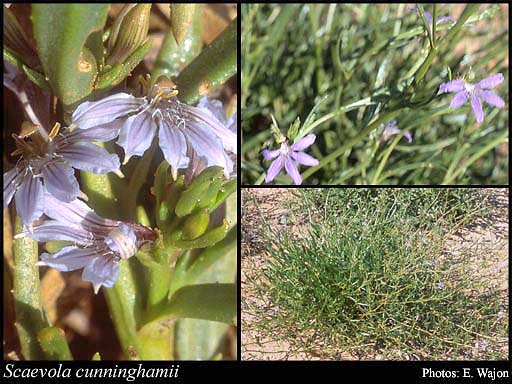- Reference
- Prodr. 7:508 (1839)
- Conservation Code
- Not threatened
- Naturalised Status
- Native to Western Australia
- Name Status
- Current
Spreading perennial, herb or shrub, 0.15-0.8 m high. Fl. blue-purple/white, May to Oct. White or red/brown sand. Sandhills, limestone rises.







Scientific Description
Stems ribbed. Leaves flat, 25-70 mm long, 1.5-6 mm wide, Indumentum absent (leaves glabrous); margins entire. Bracteoles present, 3-5 mm long, glabrous. Pedicel pedicellate, Pedicel length the pedicels 6.5-7 mm long, glabrous. Calyx lobes present, Calyx length 0-1 mm long, glabrous. Corolla blue, 11-15 mm long, without auricles, not spurred, hairy on the outside, with sparse, dendritic hairs, hairy on the inside; central lobes 7-8 mm long, with wings; outer lobes 6-10 mm long, wings present on both sides, 0.8 mm wide. Anthers free. Ovary inferior, not gibbose; style 10-11 mm long, hairy; indusium single, hairy; ovules one or two. Flowers in May, June, July, August, September and October. Occurs in the Pilbara (PIL), Murchison (MUR), Carnarvon (CAR) and Gascoyne (GAS) IBRA Region(s), of the Eremaean (E) Botanical Province.
Distribution
- IBRA Regions
- Carnarvon, Gascoyne, Murchison, Pilbara, Yalgoo.
- IBRA Subregions
- Ashburton, Augustus, Cape Range, Chichester, Edel, Roebourne, Western Murchison, Wooramel.
- IMCRA Regions
- Abrolhos Islands, Ningaloo, Pilbara (nearshore), Pilbara (offshore).
- Local Government Areas (LGAs)
- Ashburton, Carnarvon, East Pilbara, Exmouth, Greater Geraldton, Karratha, Meekatharra, Murchison, Shark Bay, Upper Gascoyne.